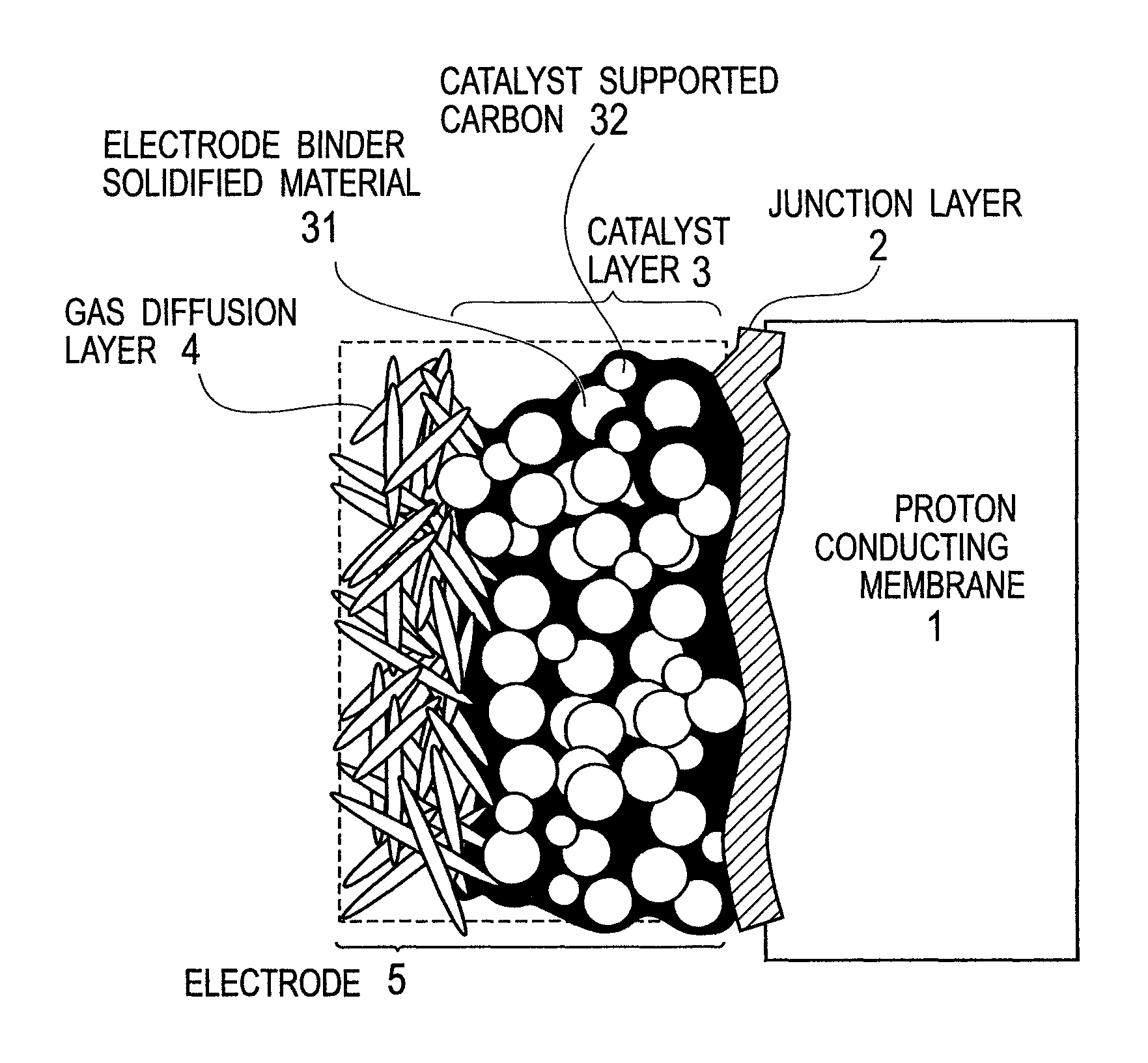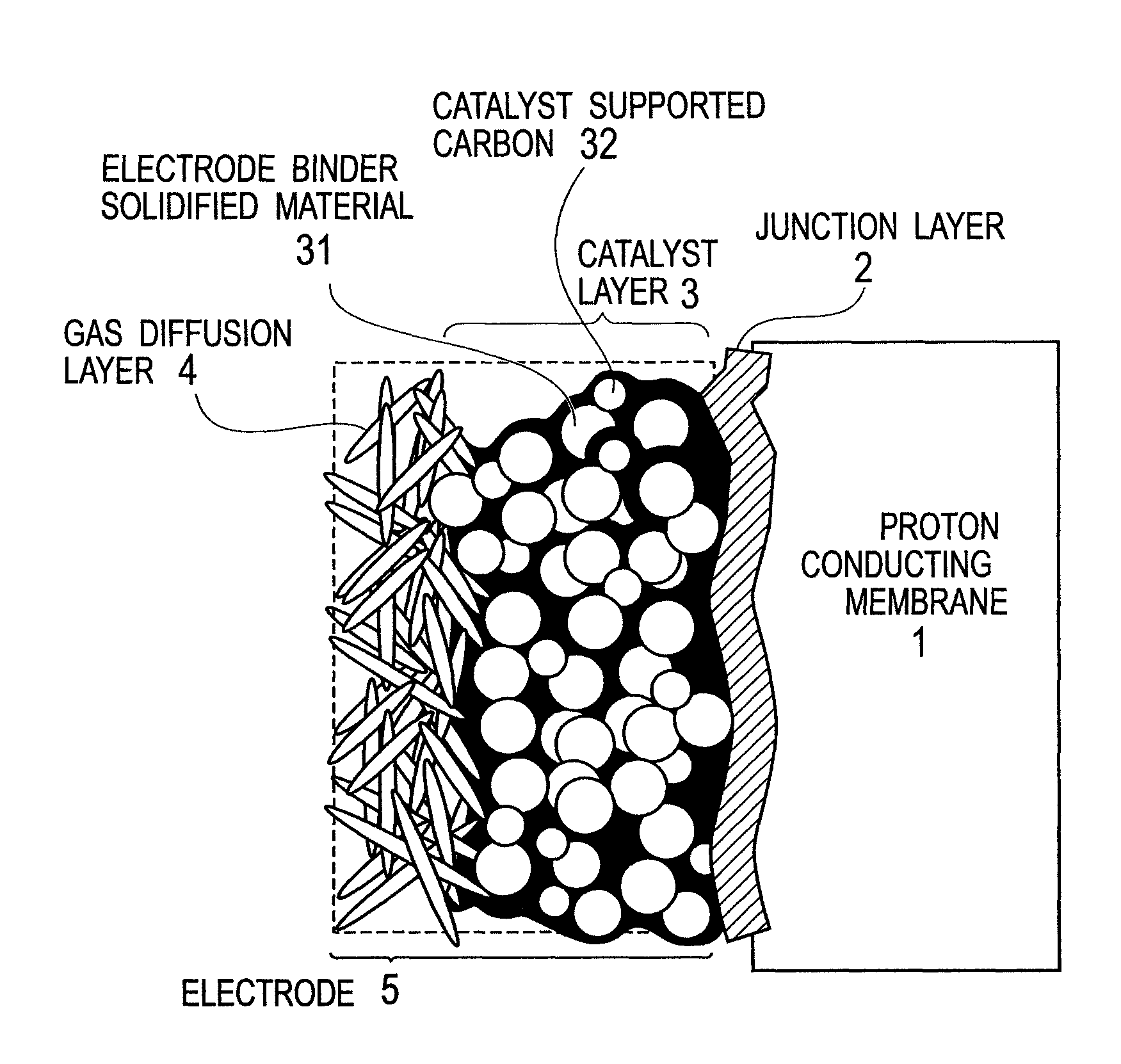Membrane-electrode junction agent, proton conducting membrane having junction layer, membrane-electrode assembly, polymer electrolyte fuel cell, and manufacturing method of the membrane-electrode assembly
a proton conducting membrane and junction layer technology, applied in the direction of cell components, final product manufacturing, sustainable manufacturing/processing, etc., can solve the problems of reducing ion conductivity, short heat resistance of sulfonated fluorine resin having the thermoplasticity, and breaking of an ion channel structure, so as to enhance power generation performance and enhance the joint strength. , the effect of high fuel barrier property
- Summary
- Abstract
- Description
- Claims
- Application Information
AI Technical Summary
Benefits of technology
Problems solved by technology
Method used
Image
Examples
example 1
1. Fabrication of Proton Conducting Membrane
[0174]21.2 g of the 3-mercaptopropyl trimethoxysilane (Sila-Ace S-810, made by Chisso Corporation), 52.5 g of tetraethoxysilane (KBE-04, made by Shin-Etsu Chemical Co., Ltd.) and 10.7 g of the methanol were measured in a flask, and were stirred for five minutes at normal temperature. To a mixture thus obtained, a solution obtained by mixing 6.2 g of 0.1N hydrochloric acid and 8.2 g of the methanol with each other was added, followed by further stirring for three hours at the normal temperature. Subsequently, a solution obtained by mixing 0.057 g of the potassium fluoride and 9.7 g of the methanol with each other was added to a resultant, and a mixed solution thus obtained was stirred for three hours while being heated to 80° C. in an oil bath. The mixed solution was cooled down to 5° C., and thereafter, the methanol was removed therefrom by fractional distillation in vacuum at 35° C. 120 mL of diethyl ether was added to an obtained solutio...
example 2
1. Fabrication of Proton Conducting Membrane
[0181]0.16 g of water and 0.060 g of triethylamine were dropped into a liquid obtained by mixing 4.37 g of the mercapto group-containing silane oligomer obtained in Example 1 and 0.51 g of the silicon oligomer KR-500 (KR-500, made by Shin-Etsu Chemical Co., Ltd.) with each other. A resultant solution was stirred for 20 minutes under the ice-cold condition, and was thereafter impregnated into a polyethylene-made porous material (membrane thickness: approximately 40 μm; average pore diameter: 0.7 μm; cut into a square with a side of 15 cm) on a fluorine resin film. Such a membrane obtained after the impregnation was covered with a fluorine resin film, and an applicator was allowed to level this resultant from the above so that a membrane thickness of the impregnated porous material (membrane) could be 45 μm. The impregnated porous material was aged at the room temperature for 16 hours while being left covered with the fluorine resin film, an...
example 3
1. Fabrication of Proton Conducting Membrane
[0185]0.12 g of water and 0.060 g of triethylamine were dropped into a liquid obtained by mixing 4.07 g of a copolymer (X-41-1805, made by Shin-Etsu Chemical Co., Ltd.) of 3-mercaptopropyl trimethoxysilane and tetraethoxysilane and 1.0 g of 1,8-bis(triethoxysilyl)octane (made by Gelest, Inc.) with each other. A resultant solution was stirred at the room temperature for 20 minutes until becoming transparent, and was thereafter developed on a fluorine film. On this solution, a polyethylene-made porous material (average pore diameter: 0.5 μm; membrane thickness: 50 μm; cut into a square with a side of 10 cm) was covered, and the porous material was impregnated with this liquid. The liquid was impregnated into the porous material by using a polyethylene-made pallet so as not to cause unevenness. Thereafter, such a membrane obtained after the impregnation was covered with a fluorine resin film, and the applicator was allowed to level this resul...
PUM
| Property | Measurement | Unit |
|---|---|---|
| particle diameter | aaaaa | aaaaa |
| temperature | aaaaa | aaaaa |
| Tg | aaaaa | aaaaa |
Abstract
Description
Claims
Application Information
 Login to View More
Login to View More - R&D
- Intellectual Property
- Life Sciences
- Materials
- Tech Scout
- Unparalleled Data Quality
- Higher Quality Content
- 60% Fewer Hallucinations
Browse by: Latest US Patents, China's latest patents, Technical Efficacy Thesaurus, Application Domain, Technology Topic, Popular Technical Reports.
© 2025 PatSnap. All rights reserved.Legal|Privacy policy|Modern Slavery Act Transparency Statement|Sitemap|About US| Contact US: help@patsnap.com



